As we have seen in the past, strengthening the muscles of the hip, thigh, and leg are essential for a runner to maintain power and health.
If you are a runner, you probably have tight hip muscles, and that is pretty expected for most of us, but is it just tightness, are weak hip muscles putting you at serious risk of injury?
The hip muscles control the mechanics of your knee, so if you have weak hip abductor muscles and poor hip rotator muscle strength, your knee is at a higher risk of injury from patellofemoral pain syndrome and iliotibial band syndrome.2
Injuries that no runner wants to have to deal with.
Additionally, weak hip muscles have been linked to a host of other running injuries, though less definitively.3
Our topic today again looks at hip strength, but in a slightly different light; we show you 5 helpful hip flexor exercises to prevent injury and improve your hip drive.
Ranging from simple exercises to strengthen hip abductors, to complicated side-stepping and squatting variations to strengthen your hip muscles, our goal is to make those hip muscles powerful to keep those injuries at bay.

What Exercises Strengthen the Hip Flexor Muscles?
An illuminating study just published this month by David Selkowitz, George Beneck and Christopher Powers looked at the relative contributions of three muscles — the gluteus medius, the gluteus maximus, and the tensor fascia lata (TFL) — to hip motion in 11 hip strength exercises.4
These three muscles are of interest because they have distinct and significant roles.
- The gluteus medius is the main abductor and external rotator of the hip.
- The gluteus maximus extends the hip and assists with abduction and external rotation.
- The TFL is an abductor of the hip, but because of its positioning, it can also contribute to internal rotation
According to John Fairclough and colleagues in the UK, a tense TFL, because it connects directly to the knee’s lateral side via the iliotibial band, may increase knee strain that could develop into or exacerbate injury.5
Therefore:
The ideal hip strength exercises are those that maximize the recruitment of the gluteus medius and maximus, while minimizing the recruitment of the TFL.
These were the characteristics whereby Selkowitz, Beneck, and Powers evaluated the 11 different hip exercises.
Using electromyography or EMG, a technique that measures the electrical impulses sent to the muscles, the researchers monitored the muscle activation levels in 20 healthy subjects during the exercises.
To quantify the relative contribution of the glutes and TFL, the researchers calculated the ratio of glute to TFL activation as measured by EMG.
The results showed significant differences in the glute-to-TFL activation ratio among the eleven exercises.
What’s the bottom line?
For injury treatment and prevention; clamshells, sidesteps, single-leg glute bridges and two variants (bent knee and extending knee) of quadruped hip extensions displayed a statistically significant difference in EMG signals in both gluteal muscles when compared to the TFL.
Clamshell exercise with band
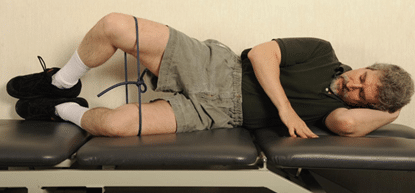
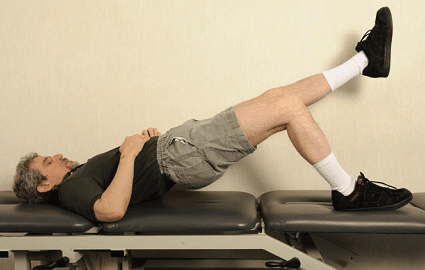
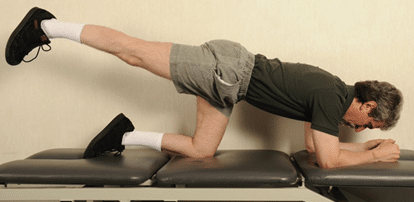
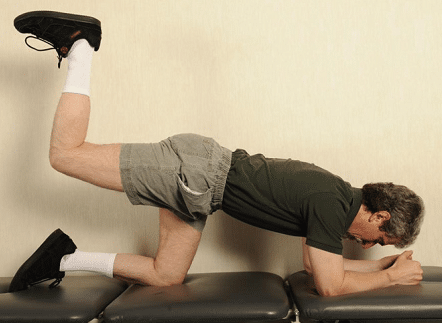
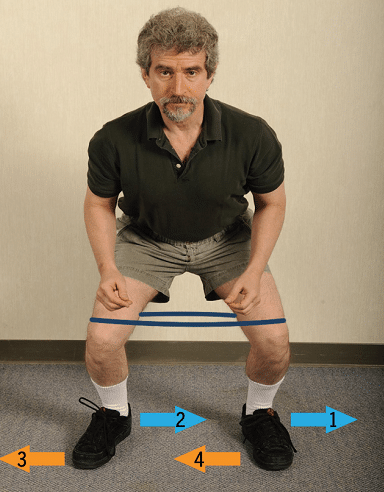
Comparatively, the side-laying leg lift, “hip hike” off a step, squats, and lunges did relatively worse.
That doesn’t mean these exercises should be eliminated from your routine.
They are still valuable and help develop overall hip strength. However, if you’re suffering from excessively weak hips, these five exercises should be your primary focus.
Are there any reasons not to use these exercises?
Unfortunately, the study did have some drawbacks.
The clamshell and sidestep exercises, which both used an elastic theraband for resistance, might have scored artificially well because of the extra resistance provided by the band.
And simply needing a special piece of equipment to do an exercise could be a drawback to some runners.
Additionally, the authors mentioned that muscle activation patterns could be altered in injured runners, necessitating different exercises. That’s a topic that would require another study to investigate.
The 5 Best Hip Strengthening Exercises for Runners
Nevertheless, the work by Selkowitz, Beneck, and Powers provides a very timely insight into the best hip strength exercises for runners.
A routine based around clamshell exercises using a theraband, side-steps, single-leg glute bridges, and quadruped hip extensions is a very good place to start, either if you have knee or hip injuries currently or would like to prevent developing them in the future.
RunnersConnect Insider Bonus
Download your FREE Hip Strengthening Exercises Guide inside your Insider Members area.
Download the video and PDF version of these 5 most effective hip exercises for runners with details on how many sets, reps, and days per week to complete this workout. You’ll get more images, full descriptions on how to perform and a video to help guide you.
Not a RunnersConnect Insider member? It’s FREE to join. Click here to get started
Original article and pictures take runnersconnect.net site
Комментариев нет:
Отправить комментарий